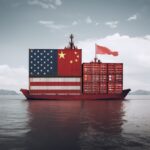
What is Dunnage?
Dunnage refers to materials used to secure and protect goods during transportation or storage. It is typically used to prevent damage to products by providing cushioning, support, and stability. Dunnage can be made from various materials, each offering different benefits depending on the specific needs of the items being transported or stored. Here are some common types of dunnage materials and considerations for choosing the right one:
- Wood: Wood is one of the most traditional materials used for dunnage. It is sturdy, readily available, and relatively inexpensive. Wood dunnage can be in the form of blocks, beams, pallets, or crates. It’s suitable for heavy items and offers good stability and support. However, wood dunnage can be bulky and may not be suitable for delicate or moisture-sensitive products.
- Plastic: Plastic dunnage is lightweight, durable, and resistant to moisture and chemicals. It can be molded into various shapes and sizes, making it versatile for different types of products. Plastic dunnage is often reusable and recyclable, making it an environmentally friendly option. It’s ideal for products that require protection from moisture or corrosion.
- Foam: Foam dunnage, such as polyethylene or polyurethane foam, provides excellent cushioning and shock absorption. It conforms to the shape of the product, offering custom protection against impacts and vibrations during transportation. Foam dunnage is lightweight and can be easily cut or molded to fit specific product shapes. It’s suitable for fragile or delicate items like electronics, glassware, or precision instruments.
- Cardboard: Cardboard dunnage, including corrugated cardboard inserts or dividers, is cost-effective and lightweight. It provides some cushioning and protection against minor impacts. Cardboard dunnage is often used for separating and organizing products within containers or boxes. However, it may not offer as much protection as other materials against heavy impacts or moisture.
- Airbags: Airbags or inflatable dunnage are made from flexible materials like polyethylene or polypropylene. They are inflated to provide cushioning and support around products, effectively securing them in place during transit. Airbags are lightweight, reusable, and adjustable, making them suitable for various product sizes and shapes. They offer excellent protection against shifting and impacts.
How to Choose the Right Dunnage Materials?
When choosing the right dunnage material, consider the following factors:
- Product fragility: Select a material that provides adequate cushioning and protection for the specific fragility of your products.
- Weight and size: Choose dunnage materials that can support the weight and size of your products without adding unnecessary bulk or weight to the packaging.
- Environmental conditions: Consider factors such as moisture, temperature, and exposure to chemicals during transportation or storage, and select dunnage materials that can withstand these conditions.
- Reusable and recyclable: Opt for materials that are reusable or recyclable to minimize waste and environmental impact.
- Cost-effectiveness: Balance the cost of dunnage materials with the level of protection they offer to ensure cost-effectiveness for your packaging needs.
Connect with Spaceship Fulfillment.
Get 30 days free storage when you book demo.
How to Determine the Appropriate Amount of Dunnage for a Shipment?
Determining the appropriate amount of dunnage for a shipment involves assessing several factors to ensure that the goods are adequately protected during transportation. Here’s a step-by-step guide to help you determine the right amount of dunnage:
- Evaluate the Fragility of the Goods: Determine how fragile the items are and their susceptibility to damage from impacts, vibrations, or compression. Fragile items will require more dunnage to provide sufficient cushioning and support.
- Assess Transportation Conditions: Consider the mode of transportation (e.g., truck, ship, air) and the potential hazards during transit, such as rough roads, turbulence, or stacking pressure. Transportation conditions will influence the level of protection needed.
- Calculate Space Constraints: Measure the dimensions of the shipping container, pallet, or packaging to understand the available space for the goods and dunnage. Ensure that the dunnage does not exceed the space allocated for the products.
- Select Dunnage Materials: Choose the appropriate type of dunnage material based on the fragility of the goods, transportation conditions, and space constraints. Consider factors such as cushioning, support, weight, and environmental resistance.
- Determine Placement and Configuration: Plan how the goods will be arranged within the shipping container or packaging. Identify areas that require extra protection or support and determine the optimal placement of dunnage materials to secure the items.
- Calculate Quantity Needed: Estimate the quantity of dunnage required based on the dimensions of the goods, the available space, and the desired level of protection. This may involve calculations or simulations to ensure adequate coverage and support.
- Consider Regulatory Requirements: Check if there are any specific regulations or guidelines for packaging and securing the type of goods you are shipping. Ensure compliance with any relevant standards or regulations to prevent damage or safety issues during transit.
- Test and Adjust: Conduct tests or trials to evaluate the effectiveness of the chosen dunnage materials and configuration. Make any necessary adjustments to optimize the protection and stability of the goods.
- Document and Communicate: Document the dunnage requirements and specifications for future reference. Communicate the packing instructions to the individuals responsible for preparing the shipment to ensure consistency and compliance.
What are the Common Mistakes to Avoid When Selecting Dunnage Materials?
Some common mistakes to avoid when selecting dunnage materials include:
- Underestimating the Amount Needed: Failing to use a sufficient amount of dunnage can lead to inadequate protection for the goods during transit.
- Using the Wrong Type or Size: Selecting dunnage that is not suitable for the specific cargo or using incorrect sizes can compromise the effectiveness of the dunnage.
- Using Damaged or Expired Dunnage: Employing dunnage that is damaged or past its useful life can lead to reduced protection and increased risk of damage to the cargo.
- Not Following Regulations and Guidelines: Ignoring industry regulations and guidelines for dunnage usage can result in non-compliance and potential damage to the shipment.
How to Properly Package Dunnage Materials for Shipping?
To properly package dunnage materials for shipping, it’s important to consider the specific characteristics of the cargo and the shipping conditions. Here are some key points to keep in mind:
- Choose the Right Material: Select dunnage materials based on the type of product, its weight, fragility, and the shipping conditions it may encounter. For example, use bubble wrap for fragile items and kraft paper or crinkle paper as gap fillers to prevent items from moving.
- Minimize Empty Spaces: Use dunnage to fill gaps, create barriers between items, and provide support for heavy or fragile items. This helps prevent items from moving within the package, reducing the risk of damage during transit.
- Consider Environmental Factors: Protect items from moisture, dust, and water contamination by using appropriate dunnage materials. For instance, bubble wrap can shield items from moisture, while kraft paper is effective for protecting against dust and water.
- Custom Solutions: For products with unique dimensions or specific needs, consider custom dunnage solutions to ensure optimal protection during shipping.
Spaceship Care: Seamless Protection for E-Commerce Success
Spaceship Care, a protective service offered by Spaceship Pro, ensures worry-free worldwide shipping for e-commerce users and shoppers. Unlike traditional carrier coverage, Spaceship Care provides full protection with just a single click during checkout, integrating seamlessly into the Spaceship Pro encounter to enhance e-commerce experiences. With Spaceship Care, users benefit from comprehensive protection, a 24/7 self-serve claim portal, and support for all carrier services available on Spaceship Pro, offering maximum coverage of up to 10,000 USD. Spaceship Care embodies a commitment to revolutionizing shipping protection, prioritizing simplicity, convenience, and peace of mind for users.
Learn more: Get Your eCommerce Parcels Protected by Spaceship Care








